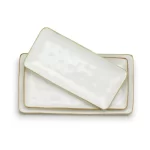Embark on a culinary journey like no other with the exquisite art of sushi, a Japanese delicacy that has captivated taste buds worldwide. This recipe embodies a harmonious union of pristine seafood, seasoned rice, and expert craftsmanship—a true reflection of Japanese culinary finesse. Each delicate roll or nigiri showcases a symphony of flavors and textures, meticulously prepared to tantalize the palate and delight the senses. With roots steeped in tradition and innovation, sushi transcends mere food to become a cultural icon celebrated for its simplicity, sophistication, and unparalleled aesthetic appeal. Prepare to immerse yourself in the world of sushi and elevate your dining experience to new heights.

What are the benefits of Sushi?
Embark on a gastronomic journey with sushi, a revered Japanese delicacy cherished for its harmonious fusion of flavors and textures. Beyond its exquisite presentation, sushi offers a spectrum of benefits that celebrate both culinary artistry and nutritional excellence. Featuring a base of vinegared rice paired with fresh seafood or vegetables, sushi provides a balanced blend of carbohydrates, proteins, and essential nutrients, promoting a well-rounded and satiating dining experience.
The incorporation of omega-3 fatty acids found in fish varieties like salmon and tuna contributes to heart health and brain function, while the presence of seaweed, a staple sushi ingredient, offers a rich source of vitamins, minerals, and antioxidants. Sushi’s light and customizable nature allows for a versatile meal option that can cater to various dietary preferences, emphasizing freshness and quality ingredients. Whether enjoyed as a light lunch or a sophisticated dinner choice, sushi embodies the essence of mindful eating, inviting individuals to savor each bite with mindfulness and appreciation for the culinary craftsmanship behind every roll and nigiri. Experience a symphony of flavors and benefits with sushi, where tradition and innovation converge to create a culinary masterpiece that nourishes both body and soul.

Step into kitchen right now!!! Let’s try Sushi together!!!
Step 1: Prepare Sushi Rice
Rinse short-grain sushi rice under cold water until the water runs clear. Cook the rice according to package instructions. Once cooked, season with a mixture of rice vinegar, sugar, and salt. Allow the rice to cool to room temperature.

Step 2:Prepare Fillings
Slice fish, vegetables, and other desired fillings into thin strips or julienne cuts. Keep fillings ready for assembling sushi rolls.

Step 3:Prepare Workstation
Place a bamboo rolling mat on a clean surface and cover it with plastic wrap. This prevents the rice from sticking to the mat.

Step 4:Assemble Sushi Rolls
Place a sheet of nori shiny side down on the bamboo mat. With damp hands, spread a thin layer of sushi rice evenly over the nori, leaving a small border at the top. Arrange fillings horizontally on the bottom third of the rice-covered nori sheet. Using the bamboo mat, roll the sushi tightly from the bottom, applying gentle pressure to seal the roll. Once rolled, use a sharp knife to slice the sushi roll into individual pieces.

Step 5:Serve and Enjoy
Arrange sushi pieces on a plate with soy sauce, wasabi, and pickled ginger. Garnish with sesame seeds or thinly sliced scallions for added flair.

In summary, sushi emerges as a culinary masterpiece that transcends mere food to become an art form deeply rooted in Japanese tradition. The delicate balance of flavors, textures, and aesthetics in each sushi piece embodies centuries of culinary evolution and craftsmanship. From the freshness of the fish to the expertly seasoned rice, every element is meticulously prepared to deliver a symphony of taste with each bite. Sushi’s allure lies not only in its exquisite taste but also in its ability to evoke a sense of cultural appreciation and culinary sophistication. Embark on a gastronomic journey with sushi and experience the sublime beauty of Japanese culinary expertise.
Print
Delicious Sushi
- Total Time: 40minutes
Description
Sushi, a traditional Japanese dish, has gained immense popularity worldwide for its exquisite flavors, artistic presentation, and health benefits. While dining out at sushi restaurants is a delightful experience, creating your own sushi at home can be equally rewarding. Embark on a culinary journey as we delve into the world of sushi making, exploring easy recipes and expert tips to elevate your sushi game.
Ingredients
- 2 cups sushi rice
- 2 1/2 cups water
- 1/4 cup rice vinegar
- 1 tablespoon sugar
- 1 teaspoon salt
- Nori seaweed sheets
- Assorted sushi fillings (such as fresh fish, cooked shrimp, crab, avocado, cucumber, etc.)
- Soy sauce, for dipping
- Pickled ginger, for serving
- Wasabi, for serving
Instructions
Step 1:Prepare Sushi Rice
- Rinse short-grain sushi rice under cold water until the water runs clear.
- Cook the rice according to package instructions.
- Once cooked, season with a mixture of rice vinegar, sugar, and salt.
- Allow the rice to cool to room temperature.
Step 2:Prepare Fillings
- Slice fish, vegetables, and other desired fillings into thin strips or julienne cuts.
- Keep fillings ready for assembling sushi rolls.
Step 3: Prepare Workstation
- Place a bamboo rolling mat on a clean surface and cover it with plastic wrap.
- This prevents the rice from sticking to the mat.
Step 4: Assemble Sushi Rolls
- Place a sheet of nori shiny side down on the bamboo mat.
- With damp hands, spread a thin layer of sushi rice evenly over the nori, leaving a small border at the top.
- Arrange fillings horizontally on the bottom third of the rice-covered nori sheet.
- Using the bamboo mat, roll the sushi tightly from the bottom, applying gentle pressure to seal the roll.
- Once rolled, use a sharp knife to slice the sushi roll into individual pieces.
Step 5:Serve and Enjoy
- Arrange sushi pieces on a plate with soy sauce, wasabi, and pickled ginger.
- Garnish with sesame seeds or thinly sliced scallions for added flair.
Equipment
 Buy Now →
Buy Now →  Buy Now →
Buy Now → 
Make 75% commission with Cooking Tips!
Buy Now →
CUCKOO CR-0675F | 6-Cup (Uncooked) Micom Rice Cooker
Buy Now →
Delamu Sushi Making Kit, Bamboo Sushi Mat
Buy Now →
TOSHIBA Rice Cooker Small 3 Cup Uncooked
Buy Now → Buy Now →
Buy Now → Notes
- Use Fresh Ingredients: Quality ingredients are key to delicious sushi. Ensure your fish is fresh and sushi-grade for best results.
- Keep Hands Moistened: Keep a small bowl of water nearby to keep your hands moist while handling sushi rice. This prevents the rice from sticking and ensures easy rolling.
- Slice with Precision: Use a sharp knife and wet it slightly before slicing sushi rolls. This helps achieve clean, uniform slices.
- Experiment with Flavors: Don’t hesitate to experiment with different fillings, sauces, and garnishes to create unique sushi combinations tailored to your taste preferences.
- Practice Patience: Sushi making is an art that requires practice. Don’t be discouraged by initial attempts, and enjoy the learning process.
- Prep Time: 20minutes
- Cook Time: 20minutes
- Category: Cooking Tips,HEALTH,RECIPE
-
How can I ensure the rice for sushi is the right consistency and stickiness?
To achieve the ideal consistency and stickiness for sushi rice, rinse the rice thoroughly before cooking to remove excess starch. Use the correct ratio of water to rice, and when cooked, season the rice with a mixture of rice vinegar, sugar, and salt while it's still warm. Gently fold the seasoning into the rice using a cutting motion to avoid crushing the grains.
-
How can I prevent the nori from becoming soggy when making sushi rolls?
To prevent the nori from becoming soggy in sushi rolls, ensure the rice layer is not too thick and covers the nori completely. Use a bamboo sushi mat to roll the sushi tightly, applying gentle pressure as you roll. Let the rolled sushi rest seam-side down for a few minutes before slicing to allow the nori to slightly re-crisp.
-
How can I select the freshest and best-quality fish for sushi?
To select fresh and high-quality fish for sushi, purchase from reputable fish markets or vendors known for their sushi-grade seafood. Look for fish with a bright color, firm texture, and a mild ocean scent. If possible, ask your fishmonger about the origin and handling of the fish to ensure it is safe for raw consumption. Alternatively, consider using frozen sushi-grade fish that has been properly handled and stored to maintain freshness.














Leave a Reply